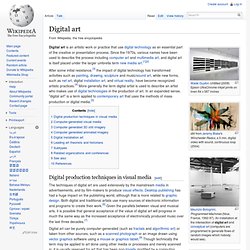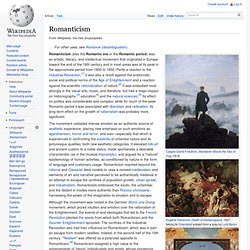

Symbolism (arts) Distinct from, but related to, the style of literature, symbolism of art is related to the gothic component of Romanticism.

The term "symbolism" is derived from the word "symbol" which derives from the Latin symbolum, a symbol of faith, and symbolus, a sign of recognition, in turn from classical Greek συμβόλον symbolon, an object cut in half constituting a sign of recognition when the carriers were able to reassemble the two halves. In ancient Greece, the symbolon, was a shard of pottery which was inscribed and then broken into two pieces which were given to the ambassadors from two allied city states as a record of the alliance.
The symbolist poets have a more complex relationship with Parnassianism, a French literary style that immediately preceded it. Children's literature. A mother reads to her children, depicted by Jessie Willcox Smith in a cover illustration of a volume of fairy tales written in the mid to late 19th century.

Children's literature or juvenile literature includes stories, books, magazines, and poems that are enjoyed by children. Modern children's literature is classified in two different ways: genre or the intended age of the reader. Children's literature can be traced to stories and songs, part of a wider oral tradition, that adults shared with children before publishing existed.
Digital art. Wade GuytonUntitled (2008) Epson UltraChrome inkjet prints on linen 84 x 587 inches still from Jeremy Blake's Winchester Redux, a 5 min. digital video with sound, continuous loop (2004) Maurizio Bolognini, Programmed Machines (Nice, France, 1992-97).

An installation at the intersection of digital art and conceptual art (computers are programmed to generate flows of random images which nobody would see). Irrationnal Geometrics digital art installation 2008 by Pascal Dombis. Graham Johnson. Folk art. Detail of 17th century calendar stick carved with national coat of arms, a common motif in Norwegian folk art.

Folk art encompasses art produced from an indigenous culture or by peasants or other laboring tradespeople. In contrast to fine art, folk art is primarily utilitarian and decorative rather than purely aesthetic.[1] Folk Art is characterized by a naive style, in which traditional rules of proportion and perspective are not employed. Closely related terms are Outsider Art, Self-Taught Art and Naïve art.[2] As a phenomenon that can chronicle a move towards civilization yet rapidly diminish with modernity, industrialization, or outside influence, the nature of folk art is specific to its particular culture. The varied geographical and temporal prevalence and diversity of folk art make it difficult to describe as a whole, though some patterns have been demonstrated.
Characteristics[edit] Folk art expresses cultural identity by conveying shared community values and aesthetics.
French. American. Canadian. Italian Renaissance. High Renaissance. Overview[edit]

Leonardo da Vinci. Leonardo is revered for his technological ingenuity.

He conceptualised flying machines, an armoured vehicle, concentrated solar power, an adding machine,[7] and the double hull, also outlining a rudimentary theory of plate tectonics. Relatively few of his designs were constructed or were even feasible during his lifetime,[nb 2] but some of his smaller inventions, such as an automated bobbin winder and a machine for testing the tensile strength of wire, entered the world of manufacturing unheralded. [nb 3] He made substantial discoveries in anatomy, civil engineering, optics, and hydrodynamics, but he did not publish his findings and they had no direct influence on later science.[8] Life. File:Última Cena - Da Vinci 5.jpg. Michelangelo. Raphael. Raffaello Sanzio da Urbino[2] (April 6 or March 28, 1483 – April 6, 1520[3]), better known simply as Raphael, was an Italian painter and architect of the High Renaissance.

Abstract art. Robert Delaunay, 1912-13, Le Premier Disque, 134 cm (52.7 in.), Private collection.

Abstract art, nonfigurative art, nonobjective art, and nonrepresentational art are loosely related terms. They are similar, but perhaps not of identical meaning. Both geometric abstraction and lyrical abstraction are often totally abstract. Among the very numerous art movements that embody partial abstraction would be for instance fauvism in which color is conspicuously and deliberately altered vis-a-vis reality, and cubism, which blatantly alters the forms of the real life entities depicted.[3][4] Romanticism. Defining Romanticism[edit] Basic characteristics[edit]

Art of Europe. The art of Europe encompasses the history of visual art in Europe.

European prehistoric art started as mobile rock, and cave painting art, and was characteristic of the period between the Paleolithic and the Iron Age.[1] Post-Impressionism. Post-Impressionism (also spelled Postimpressionism[1]) is the term coined by the British artist and art critic Roger Fry in 1910 to describe the development of French art since Manet. Fry used the term when he organized the 1910 exhibition Manet and the Post-Impressionists. Post-Impressionists extended Impressionism while rejecting its limitations: they continued using vivid colours, often thick application of paint, and real-life subject matter, but they were more inclined to emphasize geometric forms, to distort form for expressive effect, and to use unnatural or arbitrary colour.
Overview[edit] The Post-Impressionists were dissatisfied with the triviality of subject matter and the loss of structure in Impressionist paintings, though they did not agree on the way forward. Georges Seurat and his followers concerned themselves with Pointillism, the systematic use of tiny dots of colour. Defining Post-Impressionism[edit] Expressionism. Expressionism was a modernist movement, initially in poetry and painting, originating in Germany at the beginning of the 20th century.
Its typical trait is to present the world solely from a subjective perspective, distorting it radically for emotional effect in order to evoke moods or ideas.[1][2] Expressionist artists sought to express meaning[3] or emotional experience rather than physical reality.[3][4] Impressionism. Impressionism is a 19th-century art movement that originated with a group of Paris-based artists. Their independent exhibitions brought them to prominence during the 1870s and 1880s, in spite of harsh opposition from the conventional art community in France.
The name of the style derives from the title of a Claude Monet work, Impression, soleil levant (Impression, Sunrise), which provoked the critic Louis Leroy to coin the term in a satirical review published in the Parisian newspaper Le Charivari. Overview[edit] Radicals in their time, early Impressionists violated the rules of academic painting. They constructed their pictures from freely brushed colours that took precedence over lines and contours, following the example of painters such as Eugène Delacroix and J. Classicism. Classicism, in the arts, refers generally to a high regard for a classical period, classical antiquity in the Western tradition, as setting standards for taste which the classicists seek to emulate. The art of classicism typically seeks to be formal and restrained: of the Discobolus Sir Kenneth Clark observed, "if we object to his restraint and compression we are simply objecting to the classicism of classic art.
A violent emphasis or a sudden acceleration of rhythmic movement would have destroyed those qualities of balance and completeness through which it retained until the present century its position of authority in the restricted repertoire of visual images. Art history. Renaissance. The Renaissance (UK /rɨˈneɪsəns/, US /ˈrɛnɨsɑːns/, French pronunciation: [ʁənɛsɑ̃s], from French: Renaissance "re-birth", Italian: Rinascimento, from rinascere "to be reborn")[1] was a cultural movement that spanned the period roughly from the 14th to the 17th century, beginning in Italy in the Late Middle Ages and later spreading to the rest of Europe.
Edwardian era. The Edwardian era or Edwardian period in the United Kingdom is the period covering the reign of King Edward VII, 1901 to 1910, and is sometimes extended beyond Edward's death to include years leading up to World War I. Pre-Raphaelite Brotherhood.
Great Scans of Great Art. History painting. History painting, is a genre in painting defined by its subject matter rather than artistic style. History paintings usually depict a moment in a narrative story, rather than a specific and static subject, such as a portrait. Joseph Stella. Gustave Dore. Caravaggio. Gustav Klimt. John William Waterhouse. George Wesley Bellows. Jasper Johns. Johyn Everett Millais. Mark Rothko. Millet. Tintoretto.
Rosa Bonheur. Emanuel Leutze. Joan Miro. Edouard Manet. William Blake. Edgar Degas. Maud Lewis. John Collier. Theophile Steinlen. Precisionism. Spanish Renaissance. This article is about the Spanish Renaissance of the 15th-16th centuries. El Greco.